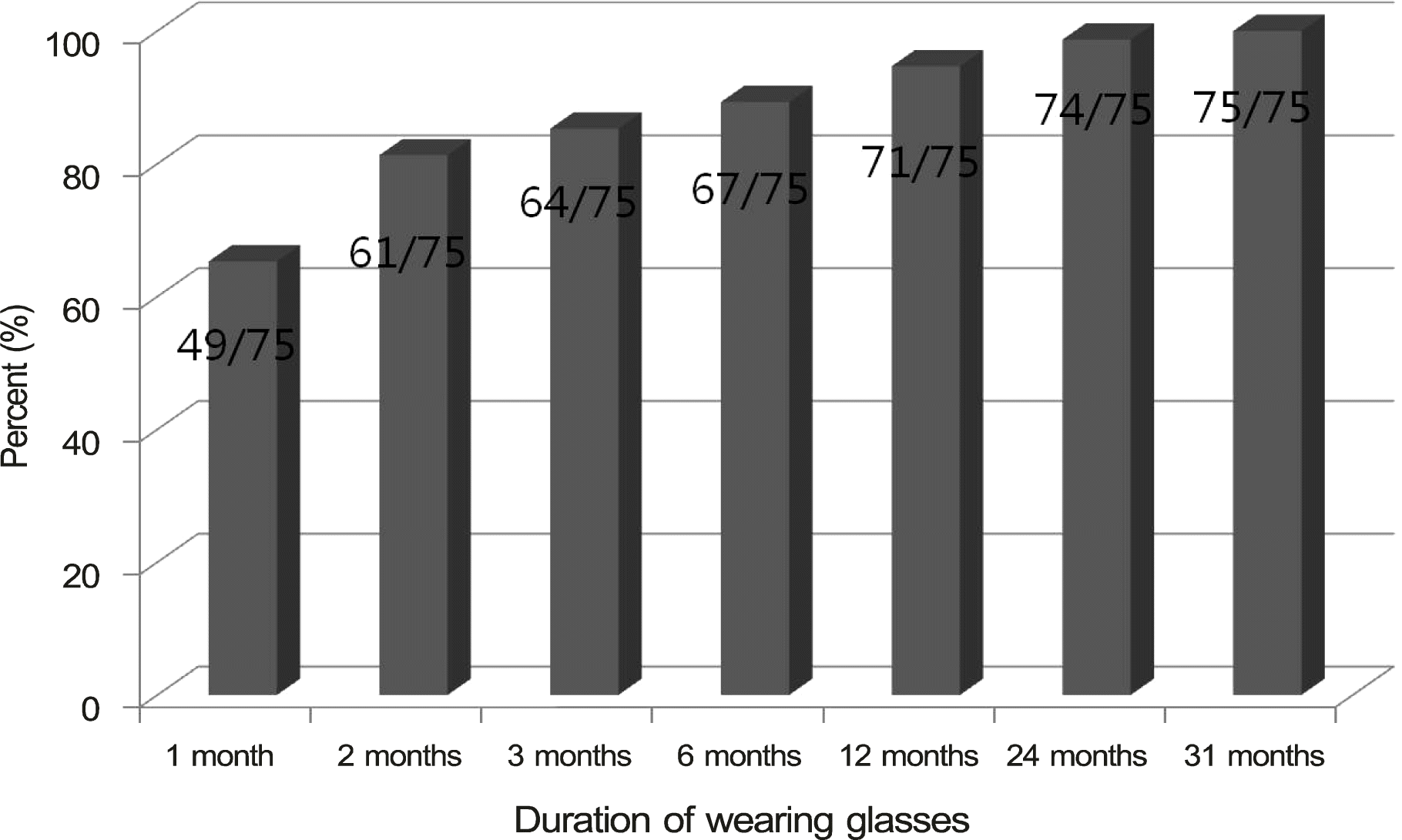초록
Purpose:
To report clinical aspects of children diagnosed with refractive accommodative esotropia after wearing their first glasses to correct hyperopia accompanied with esodeviation.
Methods:
The present study included 75 children followed up for at least 24 months. Age, spherical equivalent of refractive error, angle of deviation and presence of amblyopia were analyzed according to the duration between first wearing glasses and control of esotropia within 8 PD (≤2 months vs. >2 months).
Results:
The mean age was 4.48 ± 2.08 years and mean follow-up was 50.17 months. Initial deviation angle without glasses was 25.43 ± 10.07 PD at far, 27.72 ± 11.45 PD at near, spherical equivalent was +4.86 ± 2.41 D in right eyes, +5.05 ± 1.06 D in left eyes and 8 of 75 patients (10.67%) had ≤2 D of hyperopia. Esotropia was controlled within 8 PD with hyperopic glasses in 61 of 75 children (81.3%) within 2 months, 6 (8%) within 3-6 months, 4 (5.3%) within 6-12 months and 4 (5.3%) after 12 months. In comparison, esotropia was controlled ≤2 months in 61 of 75 children (81.3%); 14 of 75 children (18.7%) requiring >2 months had less hyperopia (+4.02 D vs. 5.17 D), more severe esodeviation both at far (30.79 ± 10.79 PD vs. 24.17 ± 9.56 PD, p = 0.03) and at near distance (34.00 ± 14.20 PD vs. 26.25 ± 10.31 PD, p = 0.02) and higher initial amblyopia prevalence rates (71.5% vs. 47.5%).
Go to : 
References
1. Von Noorden GK. Binocular vision and ocular motility. 6th ed.St. Louis: Mosby;2002. p. 311–55.
2. Wright KW, Spiegle PH. Esodeviations. Wright KW, editor. Pediatric Ophthalmology and Strabismus. 2nd ed.New York: Springer;2003. chap. 13.

3. The Korean Strabismus and Pediatric Ophthalmology Society. Esodeviation I. Lee JB, editor. Current Concepts in Strabismus. 1st ed.Seoul: Naewaehaksul;2004. chap. 7.
4. Kim C, Hwang JM. The clinical course of esotropia associated with hypermetropia after initial wearing of glasses. J Korean Ophthalmol Soc. 2003; 44:134–43.
5. Santiago AP, Ing MR, Kushner BJ, Rosenbaum AL. Clinical strabismus management: principles and surgical techniques. 1st ed.Philadelphia: WB Saunders company;1999. p. 491–505.
6. Pollard ZF. Accommodative esotropia during the first year of life. Arch Ophthalmol. 1976; 94:1912–3.

9. Sohn HJ, Paik HJ. Clinical features of refractive accommodative esotropia according to the age of onset. J Korean Ophthalmol Soc. 2006; 47:941–6.
11. Pollard ZF, Greenberg MF. 20 unusual presentations of accommodative esotropia. J AAPOS. 2002; 6:33–9.

12. Coats DK, Avilla CW, Paysse EA, et al. Early-onset refractive accommodative esotropia. J AAPOS. 1998; 2:275–8.

13. Manley DR. Strabismus. Harley RD, editor. Pediatric Ophthalmology. 3rd ed.Philadelphia: WB Saunders;1991. p. 139.
14. Kwon JY, Lee DE, Song HC. Clinical studies on accormmodative esotropia. J Korean Ophthalmol Soc. 1997; 38:687–91.
15. Lim SJ, Lee SY, Lee YC. Change of refractive error in patients with refractive accommodative esotropia. J Korean Ophthalmol Soc. 2007; 48:822–7.
Go to : 
 | Figure 1.Cumulative distribution of successful outcomes (correction within 8 PD after wearing glasses). PD = prism diopter. |
Table 1.
Clinical features of children diagnosed with refractive accommodative esotropia
Table 2.
Baseline spherical equivalent (SE) distribution (n = 75)
Table 3.
Distribution of angle of deviation (n = 75)
Table 4.
Distribution of successful outcomes (correction with-in 8 PD after wearing glasses) (n = 75)
Table 5.
Comparison according to the duration between wearing glasses and correction of esotropia within 8 PD
Table 6.
Clinical features of anisometropia group




 PDF
PDF ePub
ePub Citation
Citation Print
Print


 XML Download
XML Download